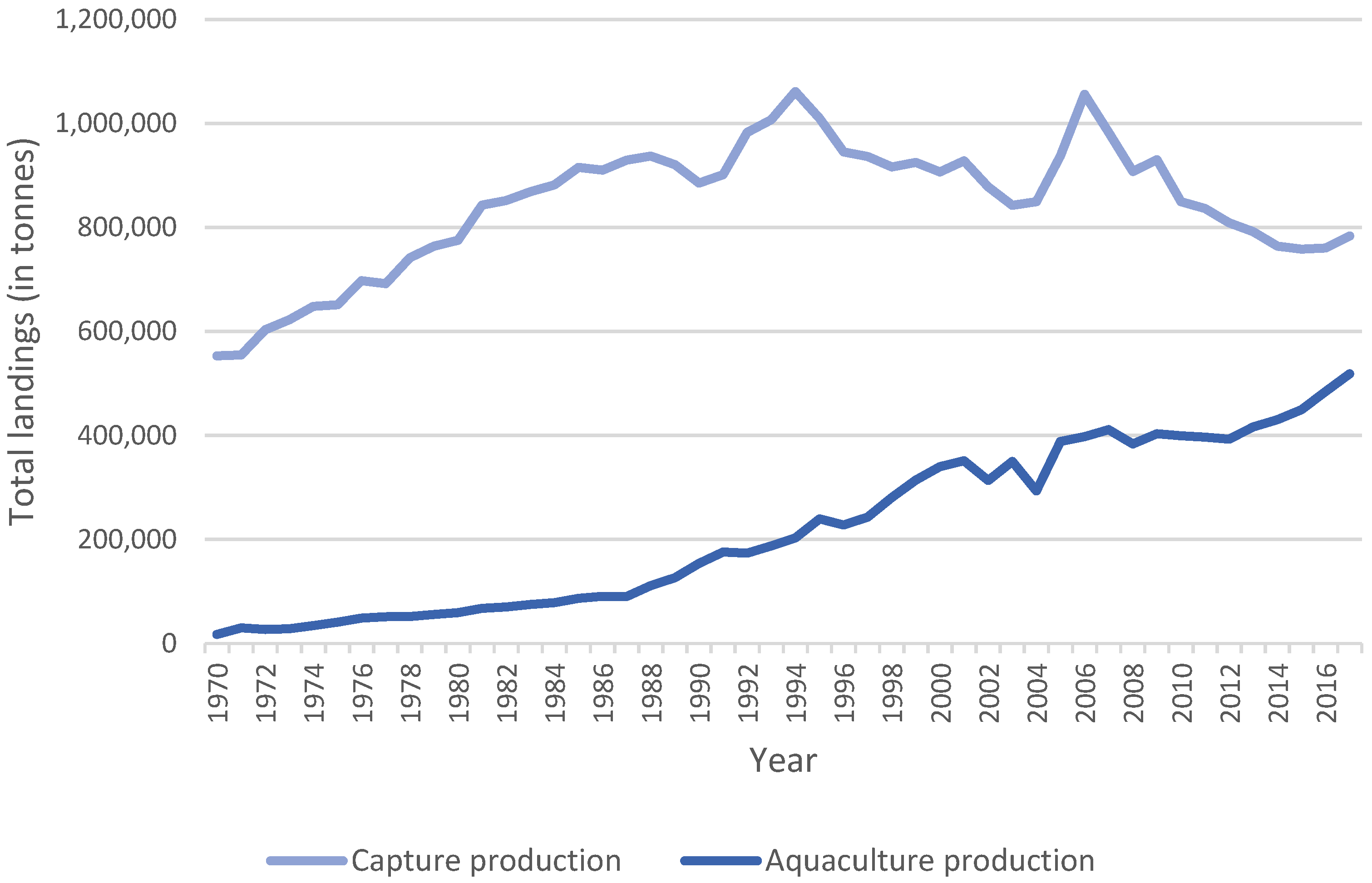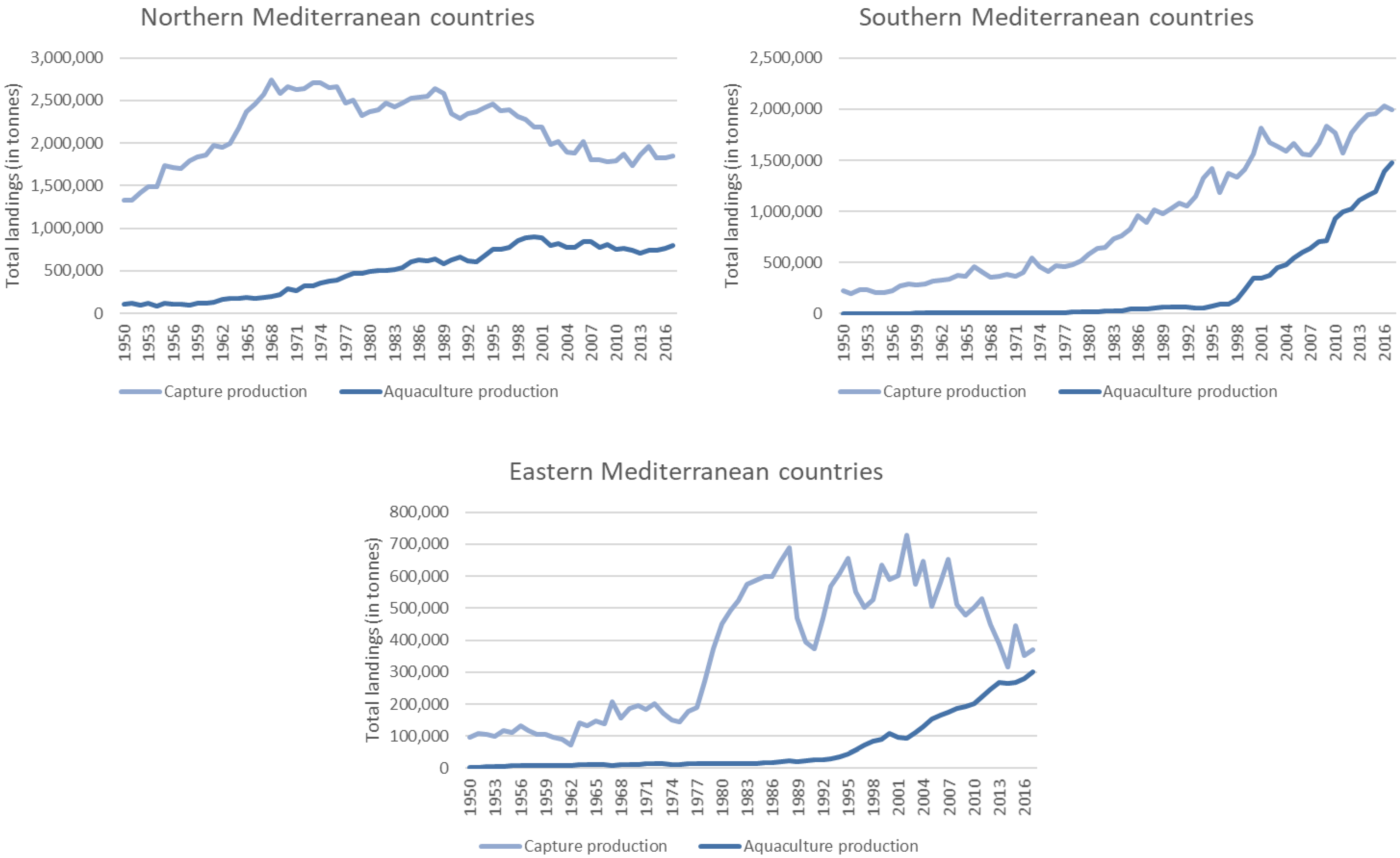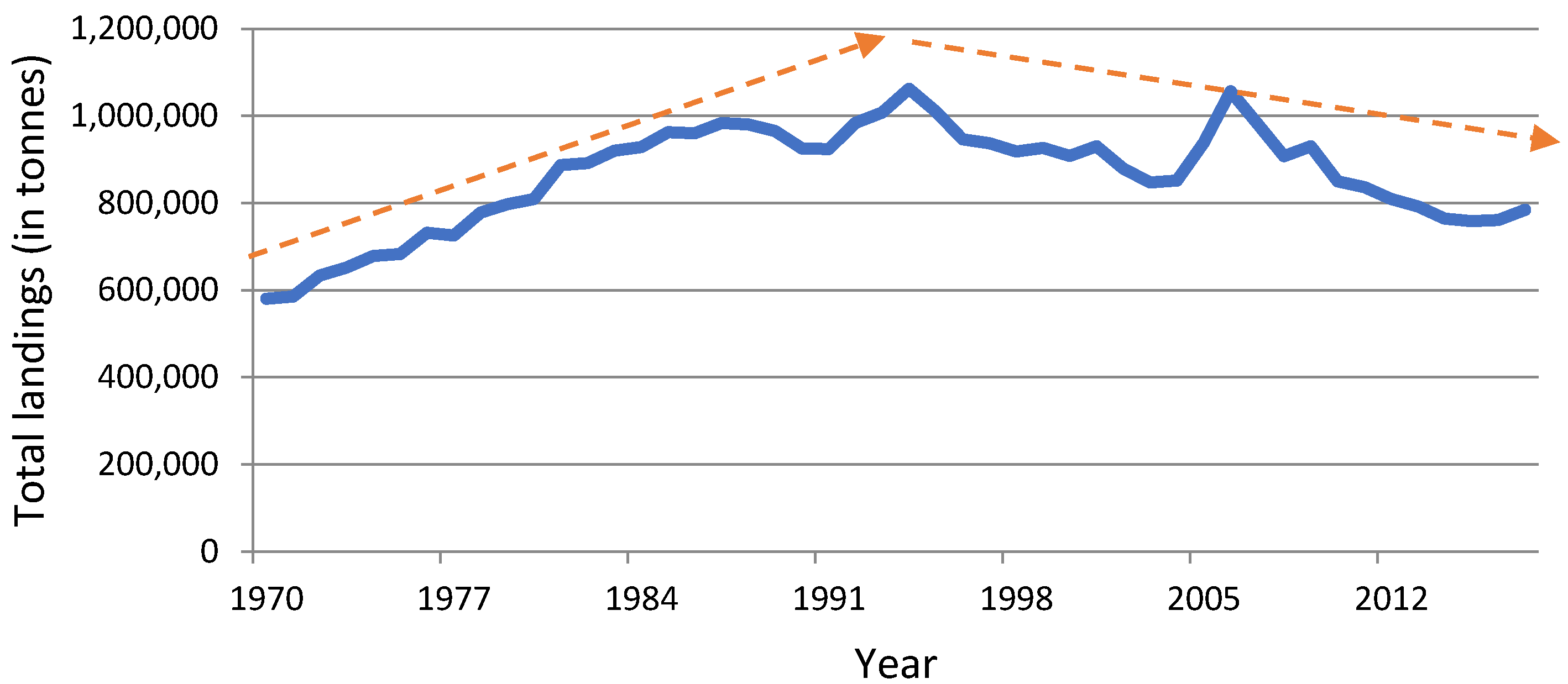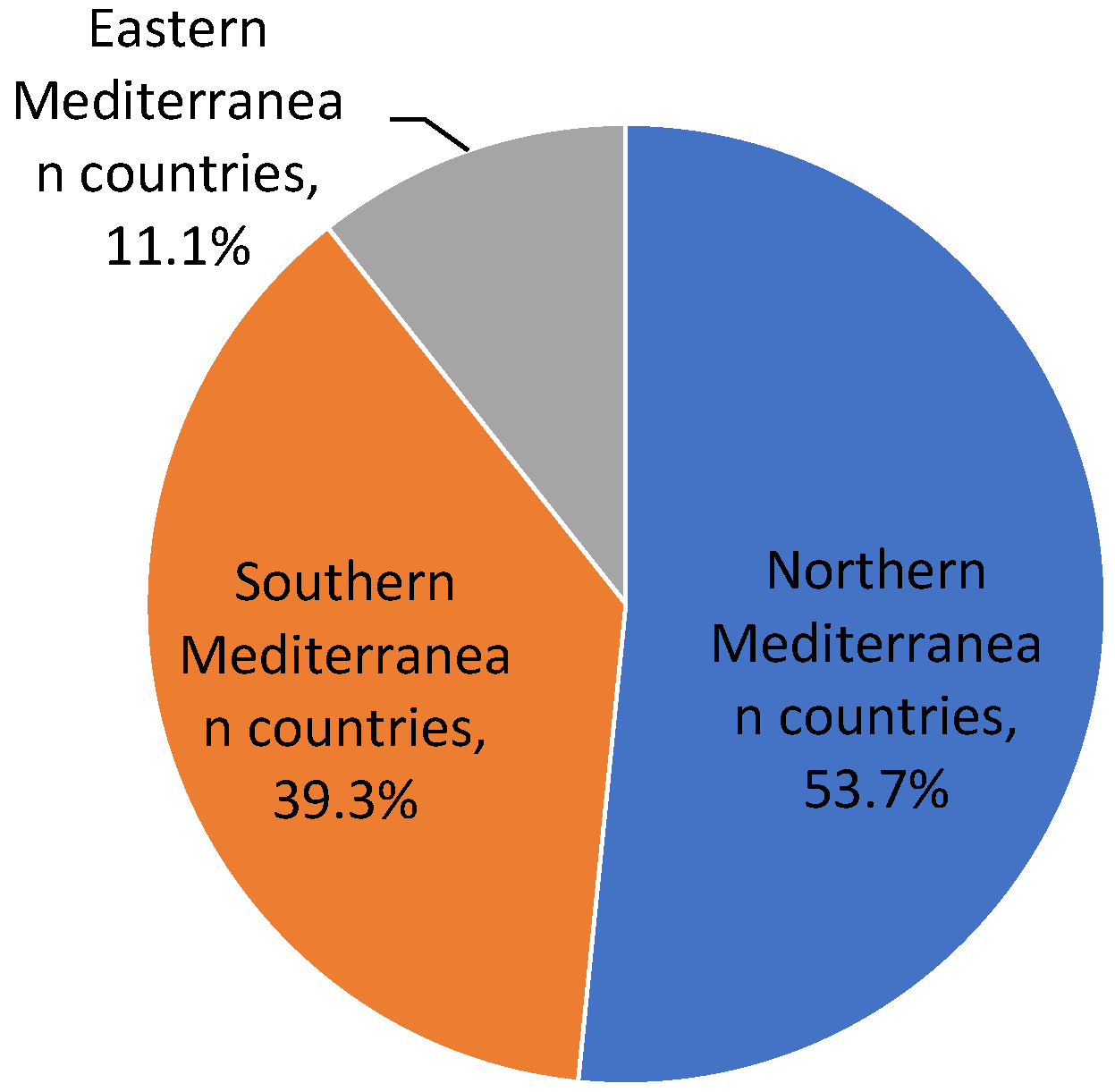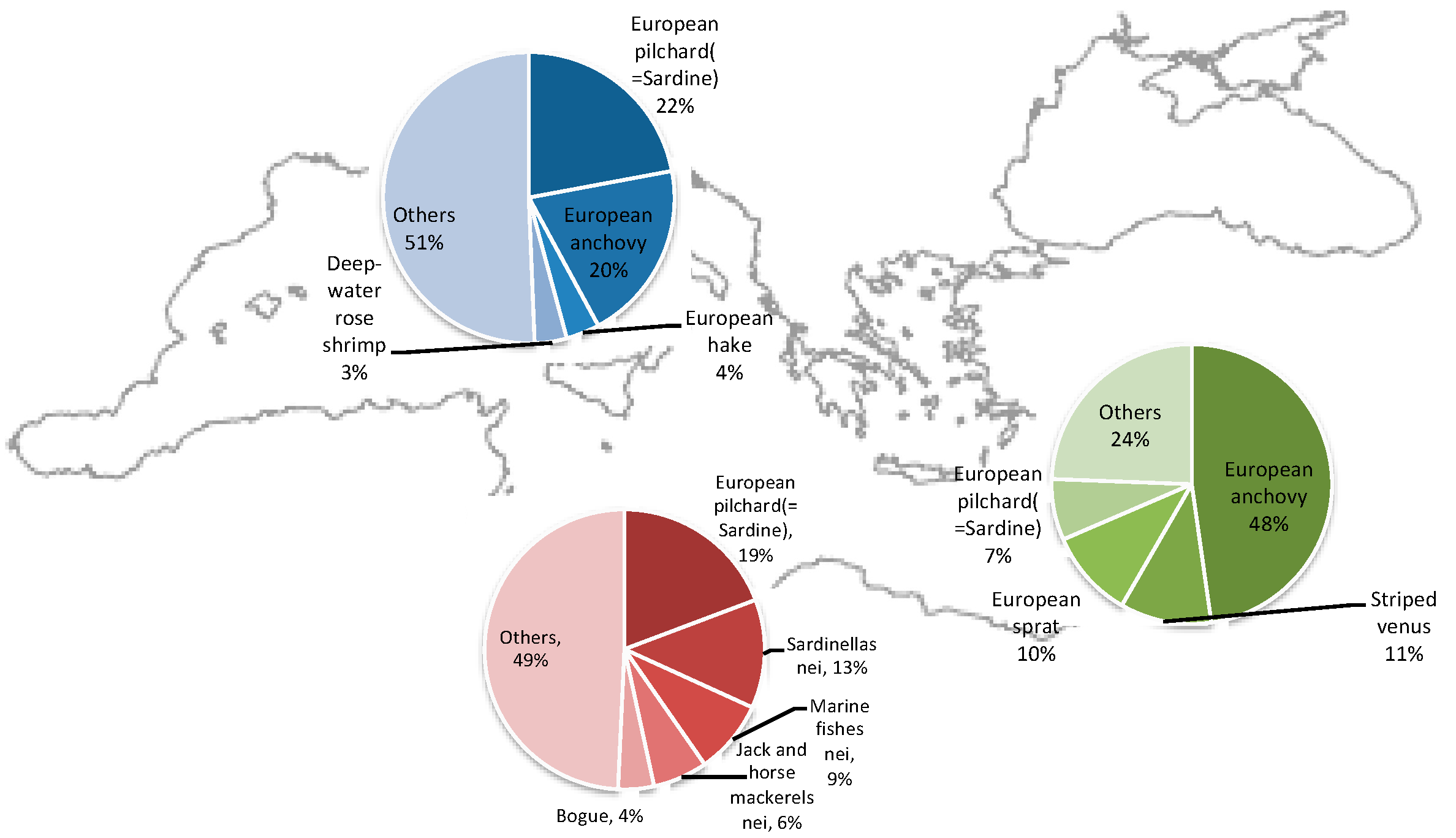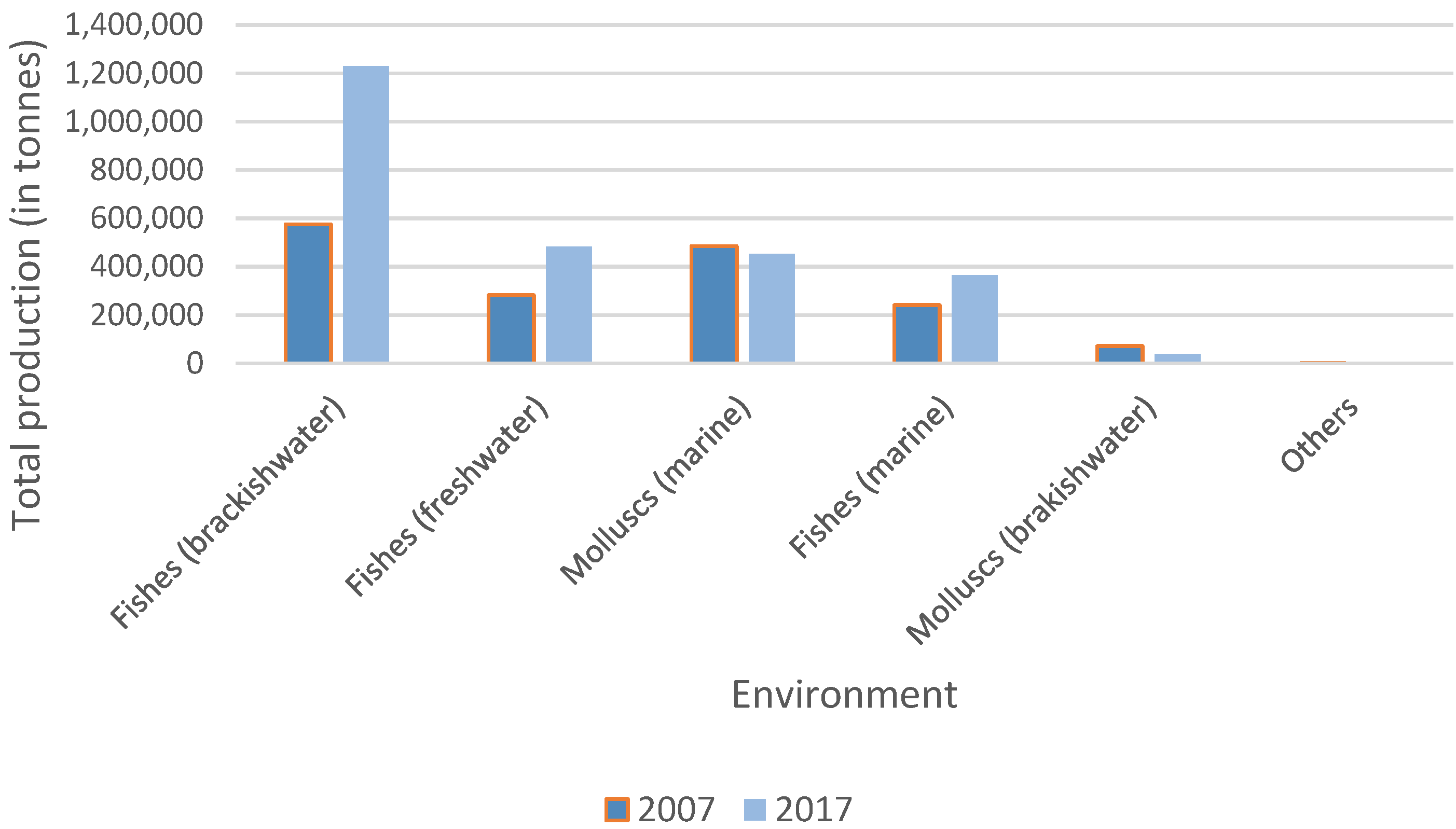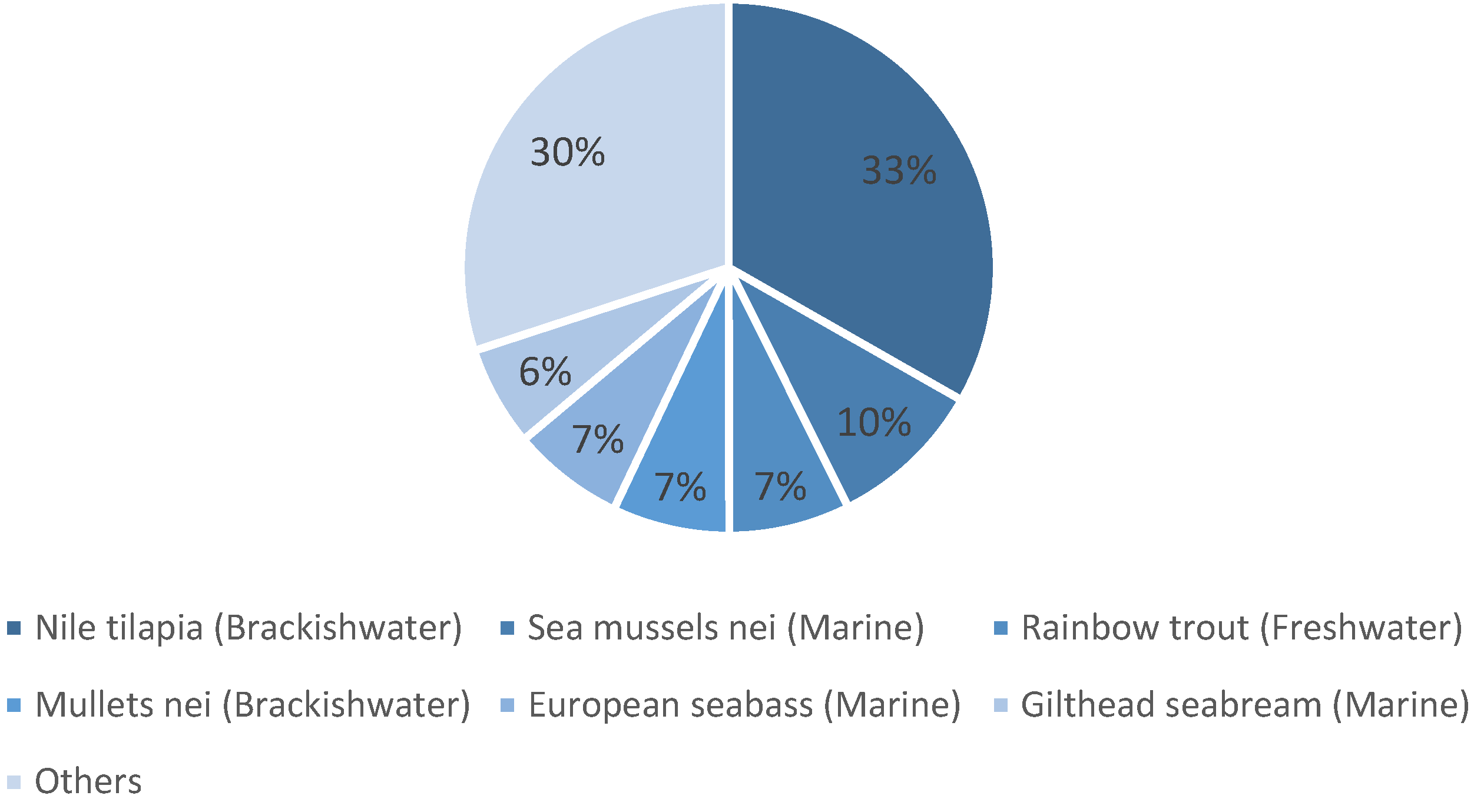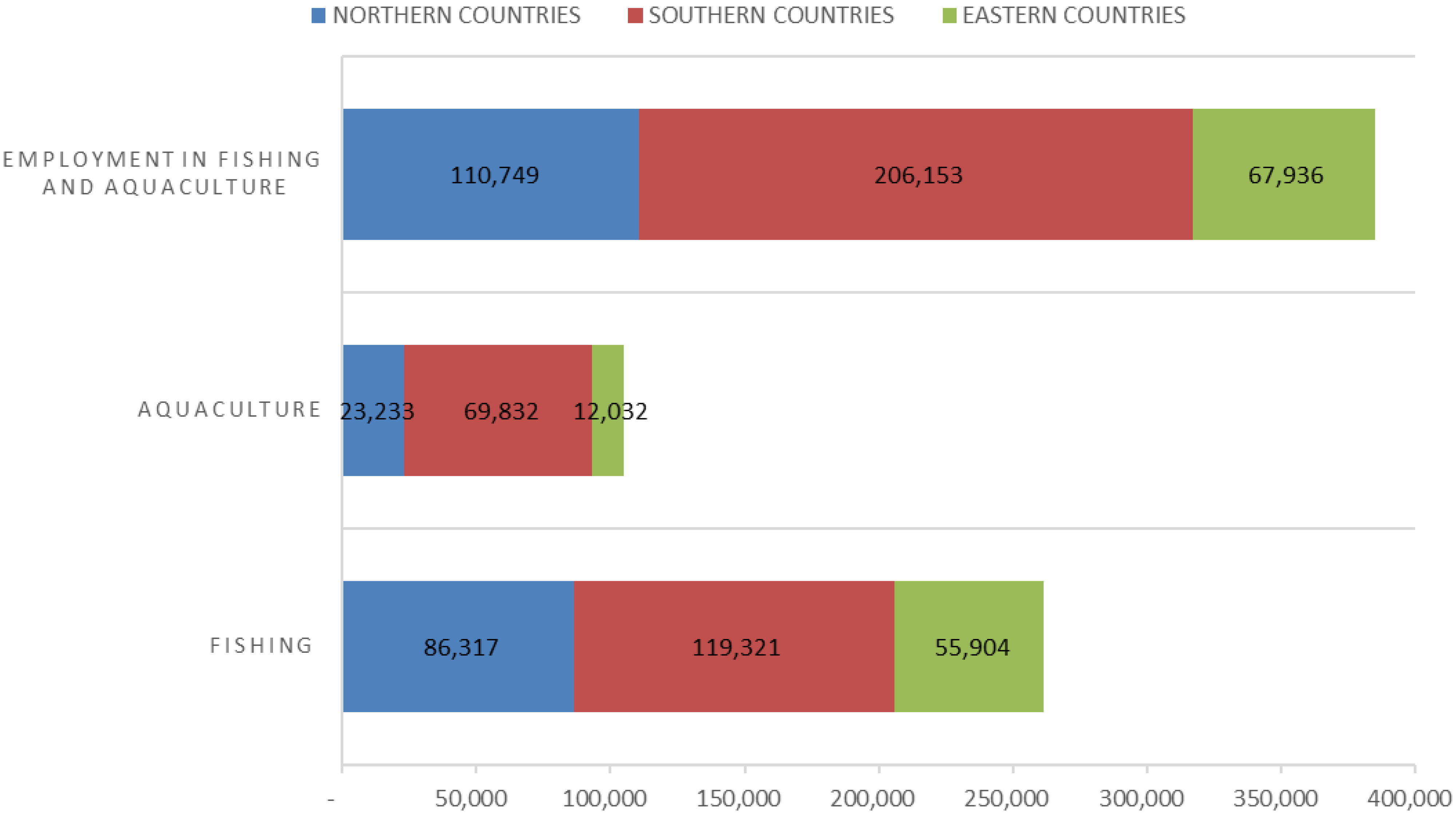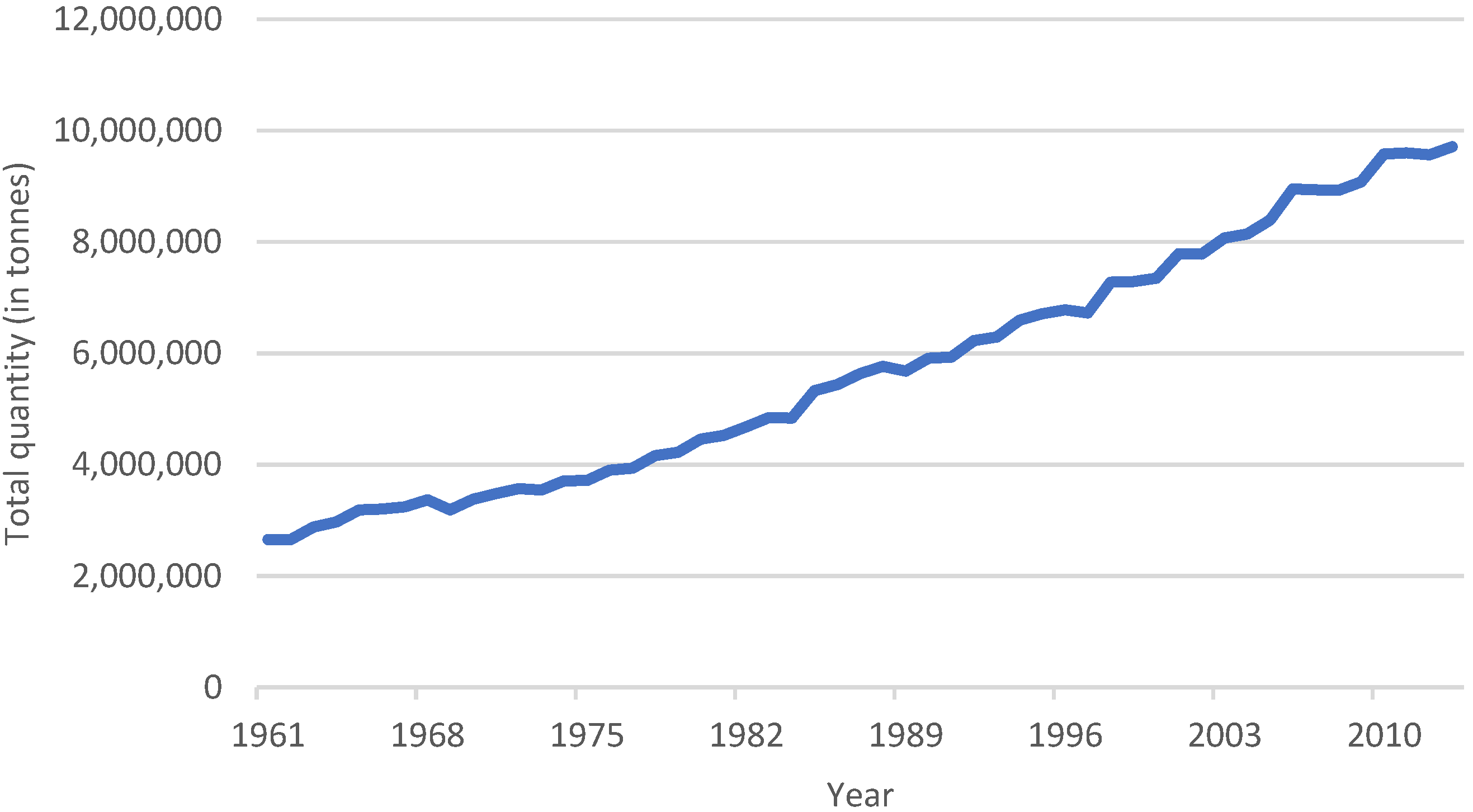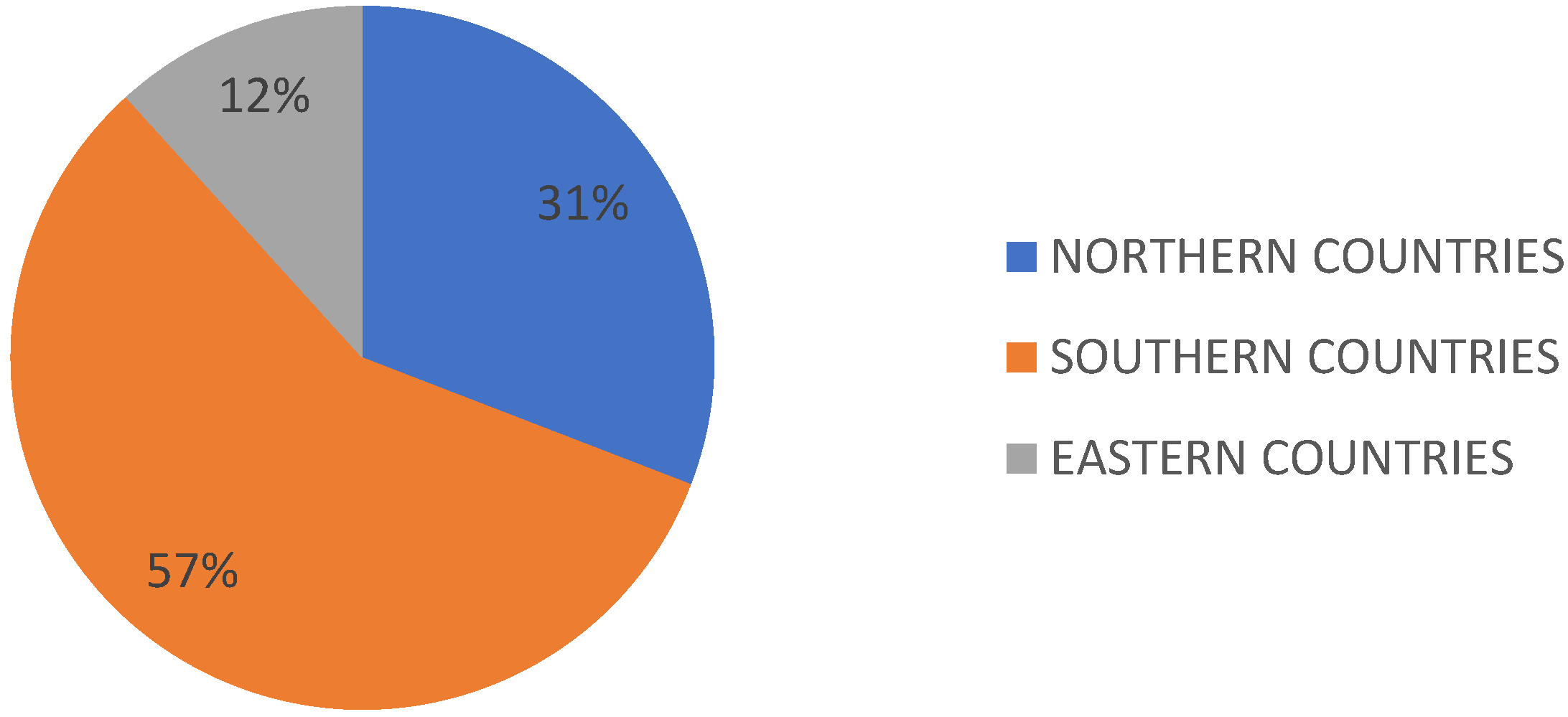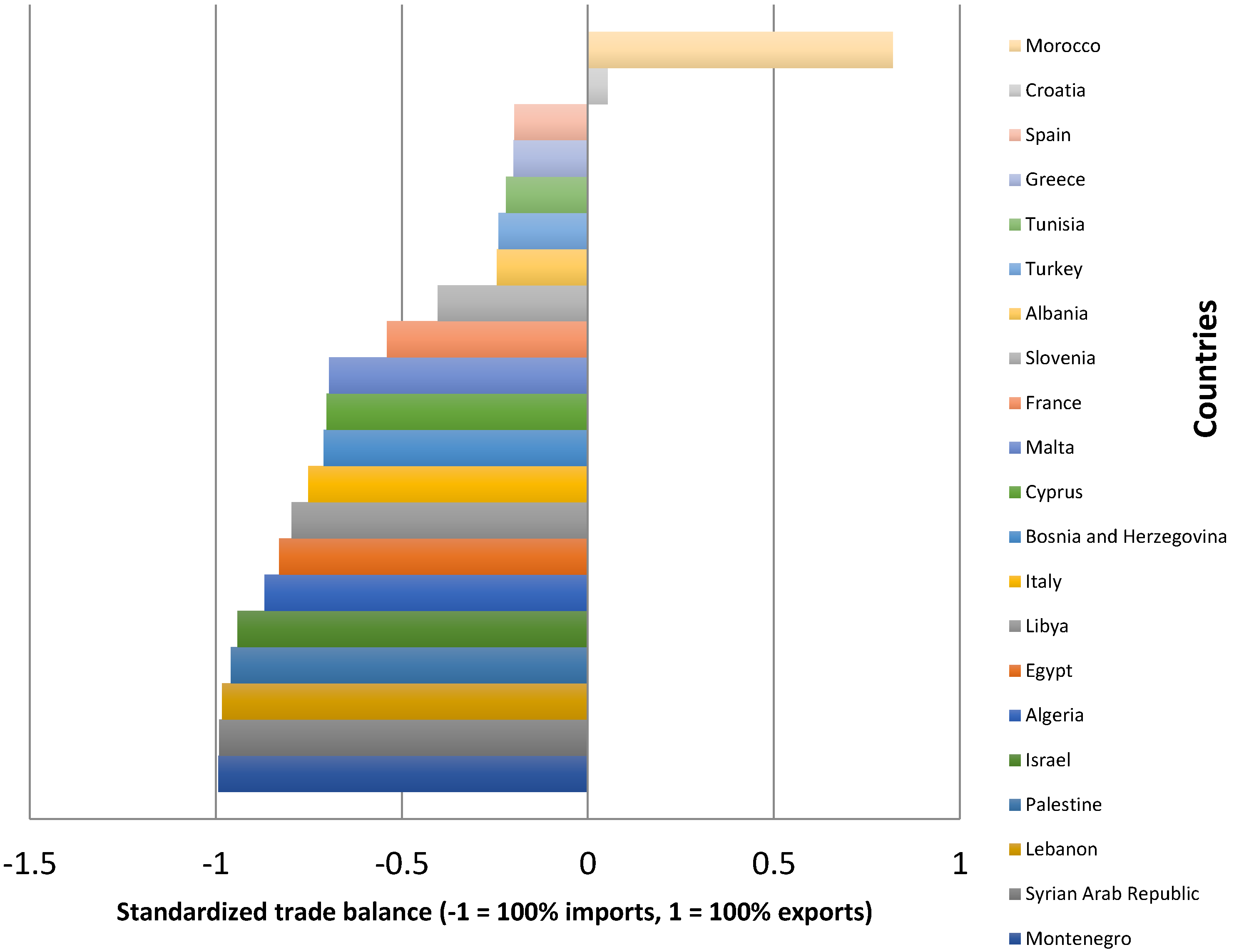In this section, we consider the risks that threaten the Mediterranean fisheries. These risks can be environmental or due to the socio-economic characteristics of the fisheries section in each country or area.
3.1. The Main Environmental Risks
The main environmental risks are warming, ocean acidification (OA), hypoxia, deoxygenation, pollution and habitat loss. If we consider the response to climate change and acidification of economically relevant Mediterranean species, there are still gaps in information. There is a growing knowledge on the consequences of climate change (CC) and OA on species but there are not enough studies that address the responses of commercial species to climate change and acidification in the Mediterranean Sea [
9,
13,
28,
29]. Revenues from fisheries will also be affected by the distribution of species and the spatial structure of populations that are impacted by warming seawater. The phenomenon of meridionalization, where native thermophilic species of southern warmer waters are now moving north, will have both positive and negative impacts on Mediterranean fisheries. The rise in the abundance of thermophilic species could increase the richness in the northern and central regions of the Mediterranean. However, this expansion could threaten the ecosystems by modifying them and there could be a risk of a decrease to extinction for several species of commercial interest [
30]. The northward retreat of cold-water species caused by warming water occurs particularly in the areas of the Gulf of Lyons, the northern Adriatic and the Aegean Sea. Commercially valuable fish exploited in the eastern part of Mediterranean such as the sprat (Sprattus sprattus) are at risk of extinction and this is aggravated by other impacts such as overfishing or habitat destruction [
31]. The phenomenon of tropicalization may have dramatic consequences, particularly in the Eastern Mediterranean with a decline in several marine populations [
32,
33]. Other negative impacts would include loss of biodiversity, changes in marine communities, reduction in genetic diversity and affected food webs [
6,
33,
34]. In addition to these changes, global warming is expected to cause a decrease and reduction in fish size [
35]. Studies have shown that fish size follows a temperature rule [
36]. In a general way, the significant drop in primary production expected in the Mediterranean will affect the sectors most sensitive to changes in rainfall and river runoff and to changes in primary production [
37]. Small-scale pelagic fisheries and local communities dependent on rivers (e.g., the Ebro, Nile, Po, Tiber and Danube) are expected to be most affected by the projected changes [
30]. These changes will impact the economies of countries differently depending on their vulnerability and their composition of exploited species. Turkey and Italy being the two largest producers of fisheries in the Mediterranean, it has been observed that they do not exploit the same mix of species. Northern Mediterranean countries such as Italy have a more diversified fishery based on herring, sardines and anchovies and also target mussels, clams, cockles and ark shells, while Eastern countries such as Turkey mainly target the first group.
Countries with less diversified fisheries can then be expected to be more impacted by climate change. Climate change, which impacts pelagic and demersal fish species, increases the risk of certain types of fisheries. Fleets targeting mainly pelagic species such as seiners and longlines are less resilient and will be impacted positively or negatively [
30]. Fishing gears that depend on pelagic species (such as purse seiners) such as anchovies and sardines could see their production decrease due to the impact of reduced rainfall and a drop in primary production. This could impact coastal countries such as Turkey, which mainly bases its catch production on anchovies [
38]. On the other hand, demersal fishing gears and artisanal fishing fleets could be more resistant to the impacts of climate change on fish distribution [
39]. Given the processes of meridionalization and tropicalization and change in primary production that induce changes in species distribution and spatial population structure, impacts on fisheries will depend on adaptation measures, monitoring mechanisms and collaborative research at the regional level designed to address impacts on stocks distributed across national boundaries [
30]. Ultimately, the exploitation of the benefits and opportunities of new species will depend on consumers and the adaptation of local markets. Another factor to be taken into account in adapting fleets to climate change is their available technology. In Southern countries such as Turkey, artisanal fishermen have less technology available to increase fishing effort to counter production losses. As shown in the results, artisanal fishers in most cases own their boats and have invested their own capital in them. They, therefore, do not have a great capacity to adapt to go fishing elsewhere or to fish for other species [
40]. The artisanal fleets of the Southern Mediterranean would therefore be among the fleets most exposed to climate change.
Regarding acidification, research has shown that it has negative impacts on many species and habitats that benefit fisheries and aquaculture [
9,
10,
26,
40,
41,
42,
43]. Acidification particularly threatens species that use carbonate to form a skeleton or shell [
41]. Acidification has an impact on commercial species such as mollusks and crustaceans, which are widely present in the Mediterranean with important production sites in France, Italy and Greece [
10]. Among the taxa affected by acidification, mollusks and bivalves fare least well [
28]. Assuming that the effects of ocean acidification are particularly threatening for mussels and oysters, using seafood harvest data by country, and for the Mediterranean Sea, the vulnerability of some countries can be preliminarily assessed (
Appendix A Figure A6). It can be assumed that Italy, Greece, France and Spain will have a strong impact since they produce a lot of mussels. For oyster production, France would once again be the most threatened. The effects of acidification are detrimental to these cultures, causing mass mortality and therefore loss of income as well as adaptation costs to revive production [
29]. We can also assume that aquaculture crops would be less exposed than artisanal or recreational fishers who collect from the wild [
40]. Like industrial fleets, aquaculture operations have more technological means to counteract the loss of production.
Major economic effects could result from stratification, leading to deoxygenation, epidemics, harmful algal blooms and eutrophication that are present all over the Mediterranean basin and also threaten fisheries and aquaculture operations [
44,
45,
46,
47,
48]. It is expected that the most affected countries will be those with semi-enclosed areas as well as areas at the outlet of river estuaries, which are most at risk of eutrophication. Eutrophication impacts public health with episodes of shellfish poisoning, and changes in precipitation (causing floods) negatively impact aquaculture facilities and cause harmful algal blooms that cause disease in humans [
49]. To address the threats of climate change, acidification and eutrophication, fish farms could adopt integrated multi-trophic aquaculture that integrates fish species from different trophic levels to mimic wild ecosystem interactions and to limit waste [
50,
51]. There should also be a monitoring of the impacts of other sectors on aquaculture such as agriculture, forestry and tourism, which impact water quality in farms [
52]. Finally, we can consider the Allocated Aquaculture Zones (AADs), areas where the impacts of aquaculture on the environment and other users are minimized, as a solution for the development and sustainable management of aquaculture itself [
52,
53].
3.2. The Main Socio-Economic Risks
In this section, we study the socio-economic factors that have consequences on the fisheries sector in the different Mediterranean countries.
Demography can have an impact on the fisheries sector. The total population of the Mediterranean countries rose from 276 million inhabitants in 1970 to 412 million in 2000 and then to 514 million in 2018 [
1]. It is estimated that the population should reach 529 million by 2025 [
54]. More than half of the population lives on the southern shore of the Mediterranean. The population is concentrated on the coasts with a higher density in the Western Mediterranean, on the western shore of the Adriatic Sea, on the eastern shore of the Aegean-Levantine region and in the Nile Delta [
54].
The history of the Mediterranean has led to a complex socio-political scenario with a diversification of economic and social development, which is reflected in the levels of development. From an economic point of view, we can distinguish the Northern Mediterranean countries from the others with their demographic structure (aging in the North and youth in the South) [
55,
56]. This socio-economic gap between the European and Afro-Asian shores, on the other hand, is reflected in indicators such as gross domestic product (GDP) and the Human Development Index (
Table A1). The GDP per capita of the poorest country is 30 times lower than that of the richest (excluding Monaco) for the Mediterranean countries (see
Appendix A Table A1). There are significant inequalities between the different Mediterranean countries. In general, the Northern countries benefit from a better economic, welfare and governance situation [
57]. In 2010, Mediterranean countries reached 11.1% of the world’s GDP. In the same year, France, Spain and Italy accounted for 64% of this GDP [
10]. Moreover, the total population of the Middle East and North Africa as a whole has increased from 105 million in 1960 to 448 million in 2010 [
12]. As their populations grow, they are vulnerable due to uneven distribution of resources, a difficult political context and migration.
The number of persons employed, directly or indirectly, in the fisheries sector also creates a kind of vulnerability if this sector shrinks due to environmental risks. Direct employment in fishing for the Mediterranean countries was less than 261,000 workers and less than 105,000 thousand workers in aquaculture for a total of 367 thousand jobs generated by this sector (see
Appendix A Table A2). Fishing catches provided 71% of employment against 29% for aquaculture. The main countries contributing to employment in the fisheries and aquaculture sectors were Egypt with 22%, Libya with 13%, Tunisia with 12%, Turkey with 11%, Spain with 9% and Greece with 8%. Egypt dominated employment with 86,000 workers for employment in fisheries and aquaculture. Egypt also dominated the aquaculture sector, providing 33% of jobs.
Concerning jobs in the Mediterranean basin, Sacchi [
12] reported for the year 2008 a total of 250,000 jobs in the primary sector associated with fishing catches and 123,000 jobs for aquaculture. The number of indirect jobs was 214,000. His results also suggested that Egypt was the country where fishing and aquaculture provide the largest number of jobs and more particularly that the countries of the South dominate the number of jobs in the fishing and aquaculture sector in the Mediterranean.
An analysis by region shows that for the Mediterranean countries, the Southern Mediterranean countries as a whole had the highest number of employment in fishing and aquaculture, contributing to 56% of the employment in fishing (119,321 jobs) and to 66% of the employment in aquaculture (69,832 jobs), accounting for 53% of the total employment (206,153 jobs) (See
Appendix A Figure A10). The Northern Mediterranean countries contributed to 33% of the employment for the fishing sector (86,317 jobs) and 22% to the aquaculture sector (23,233 jobs), accounting for 29% of the total employment (110,749 jobs). The Eastern Mediterranean countries contributed the least to the employment with 21% of the employment in fishing (559,904 jobs) and 12% for the employment in aquaculture (12,032 jobs), accounting for 18% of the total employment (67,936 jobs).
The evolution of the consumption of seafood can also be considered a means to reinforce or decrease the economic importance of fisheries in the different Mediterranean regions. For the Mediterranean countries as a whole, the apparent per capita consumption of all seawater fishery products has been increasing since 1961, rising from 11.3 kg per capita to 20.1 kg per capita in 2013 (see
Appendix A Figure A11). After a period of slight decline in the 1980s, the proportion of pelagic species among the marine species consumed has since increased (35% in 2013). The consumption of freshwater and diadromous fish has been steadily increasing since 1961. In 2013, pelagic fish represented 28% of total marine product consumption, followed by demersal fish (26%), freshwater and diadromous fish (21%), mollusks (11%), crustaceans (6%), cephalopods (5%) and the marine fish nei (3%) (see
Appendix A Figure A12).
In 2013, the mean estimated consumption of marine products for all Mediterranean countries was 20.1 kg per capita with a production of about 63% of their consumption (see
Appendix A Table A3). By group of countries, Northern countries exceeded the world average with 30.7 kg per capita while Southern and Eastern countries were below with 16.7 and 6.8 kg per capita, respectively. Nine countries were above the average: Cyprus (21.9 kg per capita), Egypt (22.1 kg per capita), France (33.5 kg per capita), Israel (23.2 kg per capita), Italy (25.5 kg per capita), Libya (22.6 kg per capita), Malta (32.6 kg per capita) and Spain (42.4 kg per capita). Northern countries covered only 42% of their consumption with their production, and Eastern countries covered only 84%, while Southern countries had a surplus with 104%. Only Croatia, Morocco and Turkey covered their seafood produce consumption by their capture and aquaculture yields. Other countries are therefore highly dependent on imports.
Depending on whether they are importers or exporters (fisheries trade), the impacts of the environmental threats will be different in the different Mediterranean regions. In the Mediterranean, most countries are net importers. Montenegro, the Syrian Arab Republic, Lebanon and Palestine are the most dependent on fishing imports. On the contrary, Morocco and Croatia are net exporters (see
Appendix A Figure A13). If we analyze the data from a regional point of view, it can be seen that only the Southern Mediterranean countries are net exporters. The Eastern countries and the Northern Mediterranean countries reflect the importance of trade flows between the Southern and Eastern Mediterranean countries and the Northern countries (such as the EU countries) (see
Appendix A Figure A14) [
12].
Another indicator studied is the value of the fisheries trade in the Mediterranean region. The total value of the fishery products traded (imports plus exports) is provided in
Appendix A Figure A15. The total value of the fishery products marketed by Mediterranean countries is 37.2 billion dollars. All of the countries are net importers in value except for Morocco, Tunisia, Turkey, Albania, Croatia and Greece. If we analyze the data from a regional point of view, it can be seen that only the Southern Mediterranean countries are net exporters of value. The Eastern countries and in particular the Northern Mediterranean countries are net importers, highlighting again the importance of trade flows between the Southern and Eastern Mediterranean countries and the Northern countries (such as the EU countries; see
Appendix A Figure A13).
Mediterranean fishing fleets are divided into three types according to the classification of Lleonart et al. (1998) [
58]: industrial, semi-industrial and small-scale artisanal fishing. The categories of recreational fishing and subsidence are added here to the capture fisheries in the Mediterranean. Fishing exploitation in the Mediterranean is carried out in depths ranging from 0 to 800 m, with the 400 m level being the most used. Bottom trawls, gillnets, trammel nets, dredges, traps and bottom longlines are part of the fishing gears operating in demersal areas. Small or medium pelagic species such as sardines and anchovies that live in schools are fished by pelagic trawls and purse seines. On the other hand, larger pelagic species, such as tuna, living closer to the surface and being migratory species, are caught mainly by seines, surface longlines and drift nets. The five different types of fleets: artisanal, industrial and semi-industrial fleets, subsidence and recreative are described below according to several classifications [
12,
58,
59]. Sacchi differentiates artisanal fisheries (or small-scale fisheries) and industrial fisheries with the final destination of the products, where the former will produce for the local markets and the latter will export their production.
Pauly and Zeller [
59] defined the industrial sector as a large-scale sector of a commercial nature involving large motorized boats and primarily large seiners targeting tuna and swordfish, besides hake, sardine, anchovy, and shrimp [
40]. Fleets are expensive to build, maintain and operate. Most of their catches are sold commercially. Both Mediterranean and non-Mediterranean countries fish in the region, and the non-Mediterranean countries include Russia, Japan, Korea, Georgia, Ukraine, Bulgaria, and Romania. The industrial fleets mainly target a limited number of species and operate mainly in deep waters. Sacchi [
12] adds that they are fleets that go out for several days at a time, usually over 500 GT, transport the catch and house their crew. The industrial sector prefers to fish for large catches of species such as tuna, sardines, shrimp and anchovies, which are destined for the “international fresh or frozen markets and especially for processing” [
12].
Like industrial fleets, semi-industrial fleets target national and international markets. They differ from the industrial sector by their artisanal management of their vessels. They have on board the fishing captain who owns the means of production (vessel and fishing gear). Like the industrial fleets, they use gear that can catch large quantities of fish. In the Mediterranean, there is gear such as “trawlers, sardine seiners and vessels using equipment such as mechanical towed nets, some longlines and trammel nets.” Fleets using these types of gear “generally land their catches daily and operate mainly on the continental shelf and around the continental slope” [
12].
Sacchi [
12] provides a definition of artisanal fishing that suggests that it differs from other types of fisheries by the destination of production. Artisanal fishing is defined by local markets as a production outlet versus exports for larger fishing operations. Sacchi [
12] also adds that artisanal fishing is defined by the length of the vessel. It sets a limit of 12 m for the length of an artisanal fishing vessel. It should be noted that in some countries, such as Turkey, other definitions can be adopted, such as that of the Turkish Statistical Institute, which points out that artisanal fishing operates with one fisherman on a vessel of less than 10 m and with a limit of five crew members [
60].
Artisanal or small-scale fisheries in the Mediterranean should be studied as they play an important social and economic role [
27]. The FAO report on the state of fisheries in the Mediterranean and the Black Sea [
61] showed that artisanal fisheries account for 84% of the total fishing fleet in the Mediterranean and the Black Sea with 70,000 vessels. It generates 26% of total revenue (USD 633 million) and 60% of total employment (150,000 people). Comparing their data with
The State of Mediterranean and Black Sea Fisheries 2016 [
62] (SoMFi 2016), FAO notes that the number of vessels in small-scale fisheries has decreased by about 4000 vessels (5%), while data on employment and annual earnings show that they have increased by about 15,000 people (9%) and by USD 45.3 million (7%) compared to 2016. They also note that these changes may be due in part to improved data collection.
Subsistence fishery is small-scale fishing for non-commercial and recreational purposes. This fishery is intended for family consumption and includes artisanal boats where the subsistence catch is given to the families of the crews or to the local community [
59]. The recreational fishery is defined as a fishery undertaken for non-commercial reasons or subsidence. This fishery is conducted primarily for pleasure. Occasionally, a portion of the catch may be sold [
59]. These kinds of fishery can have a local importance for coastal communities, but their role at the national level is small. Nevertheless, if subsistence and recreational fisheries are reduced due to environmental factors, the consequence on poverty and livelihoods can be significant in some areas of the Mediterranean.
Finally, another human-induced threat to the Mediterranean fisheries is overfishing. Pauly and Zeller [
59] distinguish the two types of catches: landings (i.e., catches that are retained on board and landed) and discards (mainly from the industrial fishery). In discards, fish and invertebrates are generally considered dead. To this can be added the net mortality of fishing gear and mortality caused by ghost fishing of abandoned or lost fishing gear. However, no reliable data on these discards are available, so this is a limitation of our analysis.
